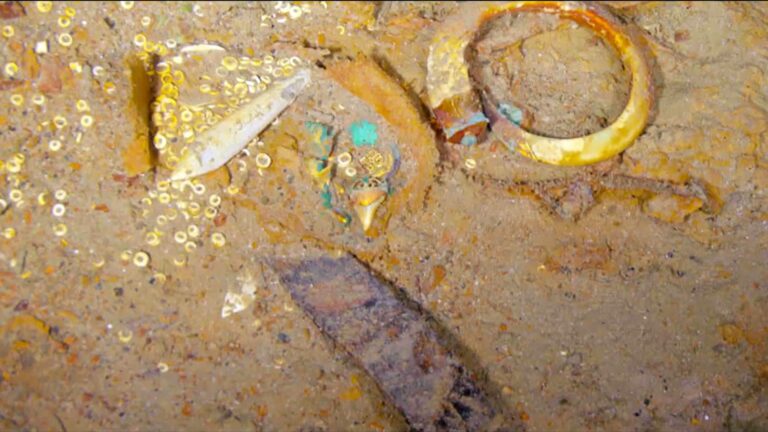A necklace made from gold and the tooth of a prehistoric Megalodon shark has been revealed for the first time since the Titanic sank 111 years ago – as the first full-sized digital scan of the doomed liner has enabled researchers to zero in on debris-field details.
Also read: Lost Titan submersible crew named
The 3D reconstruction of the 3.8km-deep liner wreck was created using deep-sea mapping on the largest scale ever attempted. The work took some 200 hours last summer, as Guernsey-based deep-sea mapping company Magellan deployed cameras mounted on two ROVs – the spectacular results can be seen on its site.
Some 700,000 still images of the wreck had to be captured from every angle to create a rendition exact in every detail, down to unopened champagne bottles, shoes, propeller serial numbers – and the now-revealed necklace.
Titanic, which sank in 1912, has been much visited using submersibles since it was located by Robert Ballard in 1985. Previous imagery had however been limited by visibility that made it impossible to capture the scale of the ship, which was originally 269m long but now lies with the bow and collapsed stern about 800m apart.
“What is not widely understood is that the Titanic is in two parts and there’s a 3sq mile debris field between the bow and the stern,” said Magellan’s CEO Richard Parkinson. “The team mapped the field in such detail that we could pick out those details.”
Apart from the logistical challenges posed by the depth of the wreck, currents affecting movement of the ROVs could be a problem, because touching any part of the wreck was strictly forbidden in case of damage. For complete perspective it had been necessary to map every square centimetre, however uninteresting, including mud in the debris field – though that thoroughness is now paying off.
Was there even an iceberg?
Parkinson described the necklace discovery as “astonishing, beautiful and breathtaking”. The company is not permitted to remove any item from the wreck-site, but is now using AI in a bid to trace the jewellery’s owner – by contacting descendants of Titanic’s 2,200 passengers and studying any footage of them boarding the ship.
Titanic experts believe the Magellan project is a major step in enabling evidence-based research, by showing the entire wreck in its true condition and in context. As rusticles eat away at it, they hope that having effectively frozen it in time will release clues as to exactly how it came to grief.
Even the infamous iceberg associated with sinking the ship is up for re-evaluation. Titanic researcher Parks Stephenson recently told the Mirror: “I’ve got a growing amount of evidence that Titanic didn’t hit the iceberg along its side, as is shown in all the movies. She may actually have grounded on the submerged shelf of the ice.
“That was the first scenario put out by a London magazine in 1912. Maybe we haven’t heard the real story of Titanic yet.”
On the 100th anniversary of the liner’s sinking in 2012, Divernet ran a Wreck Tour Special of the Titanic, conducted by Titanic sub-dive veteran Rory Golden.
Also on Divernet: Deep dive back in time on Titanic, Titanic photographer Emory Kristof dies, Titanic ‘blip’ mystery solved, Positive ID of ship that tried to save Titanic, ‘Momentous’ protection for dissolving Titanic


What a beautiful piece. Hope thet can find the rightful owners and retrieve it!